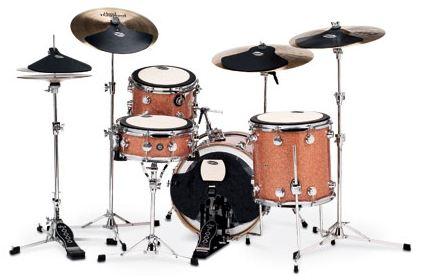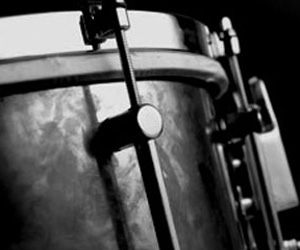Drum Tips - Practicing the Drums Quietly
 Drums can be very loud, or sometimes not loud enough. When I was playing alternative rock I never had a problem trying to keep the drums quiet – usually we had problems getting the drums loud enough to compete with the incredibly loud sounds that are produced when guitar and bass players turn their amps up to eleven! Keeping the drums quiet however, can be necessary in some situations. In many rehearsal, jazz, funk, and acoustic rock situations – there is a need to turn down the volume of the drum set.
Drums can be very loud, or sometimes not loud enough. When I was playing alternative rock I never had a problem trying to keep the drums quiet – usually we had problems getting the drums loud enough to compete with the incredibly loud sounds that are produced when guitar and bass players turn their amps up to eleven! Keeping the drums quiet however, can be necessary in some situations. In many rehearsal, jazz, funk, and acoustic rock situations – there is a need to turn down the volume of the drum set.I have known many great drummers who beat the cr*p out of their drums and sound amazing. When called in to do the MTV unplugged gig though, they need to turn down and more often than not, they don't sound so great. There is an art to getting a great drum sound at a low volume. Here are a variety of solutions that have worked for me in several different low volume situations.
Practice
The followin are techniques for practicing quietly - not rehearsing quietly which I will get to as soon as I have a little more time. This is all about the wood-shedding, getting your chops together, this is where you spend a LOT of time getting ready to play music with others - just you and the drums.Individual Practice Pad
For keeping up on stick control technique, muscle memory in your hands, and learning the fundamentals of playing odd times and syncopation – a good practice pad is essential. My personal favorite is an ironwood block with rubber pad on top that is quiet enough to practice in most public places without disturbing anybody, it is also great for warming up before shows and quietly keeping your hands warmed up while the other folks in the band are having long discussions at rehearsals.There are also many different types of commercial practice pads available that offer different playing surfaces, feels, and volumes. I like the Remo practice pads – they offer a feel very similar to a drum and are still pretty quiet.
Even an old mouse pad glued to the top of any old piece of wood will work reasonably well as a really inexpensive, semi-functional practice pad.
Full Kit Practice Pads
There are tons of good practice kits around. Made from mylar, rubber or rubber-covered wood pads set up in the same arrangement as your drum kit. Remo makes a great set, they can be quiet enough to practice in an apartment as long as your roommate isn't trying to watch TV in the same room. These are really great for working out four-way coordination, applying odd times to the full set, anything that you want to spend a lot of time going over again and again and again. A good practice pad kit will make it much easier to put in hours and hours of practice without burning out your ears and the patience of those with whom you live.Acoustic Kit Rubber Pads
A few companies produce rubber pads that sit on the batter heads of your acoustic drums and cymbals. They do cut the volume quite a bit, and like a practice pad kit they can provide enough sound deadening to make long practice sessions less deadly to your ears, but probably not enough to make rehearsal in a dorm room or apartment possible without your neighbors complaining frequently.Personally I don't like the way the rubber or neoprene sets sound or feel. They have a rebound that doesn't feel like a practice pad or a real drum. However, there are a few different companies now that have basically mounted a Remo style practice pad on top of the neoprene pad so you still get a feel pretty close to the real drum.
I believe keeping your practice sessions as similar as possible to your actual playing conditions is really, really important. I have said before - practice does not make perfect. Perfect practice makes perfect, sloppy practice makes perfectly sloppy! These pads give you a pretty good option for dramatically cutting the volume of your kit but keeping you as close to playing on the full kit as possible.
Practicing at Lower Volumes on the Full Drum Kit
No matter what other solutions you might use to lower your practice session volume remember to keep some time scheduled to practice on your kit. It is a really great idea to practice at a variety of volume levels on the kit. Try playing to a low volume stereo and making sure that you can always here the music. Low stick height, smaller, thinner sticks, and lower velocity swings are some of the keys to playing the drums at a low volume. Remember the drum set is an acoustic instrument and - like a piano, acoustic guitar, violin, or any other acoustic instrument - the drums are capable playing in an extremely wide dynamic range. Experiment with hitting different areas of the drum head to see what parts sound best at what volume.Tuning the drums to a pitch different than the drums natural resonance can also help lower the overall volume of the drums. Also thick heads - like the evans oil filled heads - tuned to very low pitches - can help lower the overall volume of a drum kit.
A good teacher can be exceedingly helpful in developing the proper technique for getting a good sound out of your drums at a low volume.

